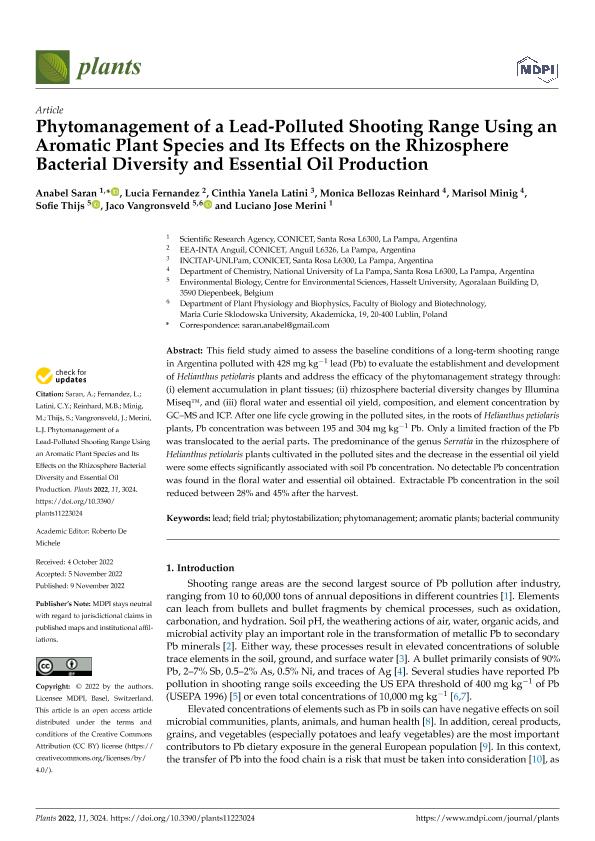Artículo
Phytomanagement of a Lead-Polluted Shooting Range Using an Aromatic Plant Species and Its Effects on the Rhizosphere Bacterial Diversity and Essential Oil Production
Saran, Anabel ; Fernandez, Lucia
; Fernandez, Lucia ; Latini, Cinthia Yanela
; Latini, Cinthia Yanela ; Bellozas Reinhard, Monica; Minig, Paola Marisol
; Bellozas Reinhard, Monica; Minig, Paola Marisol ; Thijs, Sofie; Vangronsveld, Jaco; Merini, Luciano Jose
; Thijs, Sofie; Vangronsveld, Jaco; Merini, Luciano Jose
 ; Fernandez, Lucia
; Fernandez, Lucia ; Latini, Cinthia Yanela
; Latini, Cinthia Yanela ; Bellozas Reinhard, Monica; Minig, Paola Marisol
; Bellozas Reinhard, Monica; Minig, Paola Marisol ; Thijs, Sofie; Vangronsveld, Jaco; Merini, Luciano Jose
; Thijs, Sofie; Vangronsveld, Jaco; Merini, Luciano Jose
Fecha de publicación:
11/2022
Editorial:
MDPI
Revista:
Plants
ISSN:
2223-7747
Idioma:
Inglés
Tipo de recurso:
Artículo publicado
Clasificación temática:
Resumen
This field study aimed to assess the baseline conditions of a long-term shooting range in Argentina polluted with 428 mg kg−1 lead (Pb) to evaluate the establishment and development of Helianthus petiolaris plants and address the efficacy of the phytomanagement strategy through: (i) element accumulation in plant tissues; (ii) rhizosphere bacterial diversity changes by Illumina Miseq™, and (iii) floral water and essential oil yield, composition, and element concentration by GC–MS and ICP. After one life cycle growing in the polluted sites, in the roots of Helianthus petiolaris plants, Pb concentration was between 195 and 304 mg kg−1 Pb. Only a limited fraction of the Pb was translocated to the aerial parts. The predominance of the genus Serratia in the rhizosphere of Helianthus petiolaris plants cultivated in the polluted sites and the decrease in the essential oil yield were some effects significantly associated with soil Pb concentration. No detectable Pb concentration was found in the floral water and essential oil obtained. Extractable Pb concentration in the soil reduced between 28% and 45% after the harvest.
Archivos asociados
Licencia
Identificadores
Colecciones
Articulos(CCT - PATAGONIA CONFLUENCIA)
Articulos de CTRO.CIENTIFICO TECNOL.CONICET - PATAGONIA CONFLUENCIA
Articulos de CTRO.CIENTIFICO TECNOL.CONICET - PATAGONIA CONFLUENCIA
Articulos(INCITAP)
Articulos de INST.D/CS D/L/TIERRA Y AMBIENTALES D/L/PAMPA
Articulos de INST.D/CS D/L/TIERRA Y AMBIENTALES D/L/PAMPA
Citación
Saran, Anabel; Fernandez, Lucia; Latini, Cinthia Yanela; Bellozas Reinhard, Monica; Minig, Paola Marisol; et al.; Phytomanagement of a Lead-Polluted Shooting Range Using an Aromatic Plant Species and Its Effects on the Rhizosphere Bacterial Diversity and Essential Oil Production; MDPI; Plants; 11; 22; 11-2022; 1-10
Compartir
Altmétricas



